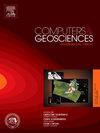利用多线圈刚性导波电磁感应测量估算导电率模型
IF 4.2
2区 地球科学
Q1 COMPUTER SCIENCE, INTERDISCIPLINARY APPLICATIONS
引用次数: 0
摘要
多线圈配置仪器的电磁感应测量用于获取地下电导率分布信息。由此产生的反演问题可能没有唯一且稳定的解。在这种情况下,局部反演方法可能会陷入局部最小值而导致错误的解。在本研究中,我们评估了两层和三层电导率模型的反演问题的好求解性。我们发现,对于双层模型,只有当测量数据中同时存在同相数据和正交数据时,才能确保唯一性。高斯-牛顿反演和查找表的结果表明,解空间是凸的。此外,我们还证明,即使是简单的三层模型,这些测量数据也不足以得出正确或稳定的解。对于两层以上的模型,独立的先验信息是解决逆问题的必要条件。从数值示例中获得的启示将应用于一个实地案例。本文章由计算机程序翻译,如有差异,请以英文原文为准。
Estimation of electrical conductivity models using multi-coil rigid-boom electromagnetic induction measurements
Electromagnetic induction measurements from multi-coil configuration instruments are used to obtain information about the electrical conductivity distribution in the subsurface. The resulting inverse problem might not have a unique and stable solution. In that case, a local inversion method can be trapped in a local minimum and lead to an incorrect solution. In this study, we evaluate the well-posedness of the inverse problem for two and three-layered electrical conductivity models. We show that for a two-layered model, uniqueness is ensured only when both in-phase and quadrature data are available from the measurements. Results from a Gauss–Newton inversion and a lookup table demonstrate that the solution space is convex. Furthermore, we demonstrate that for even a simple three-layered model, the data contained in such measurements are insufficient to reach a correct or stable solution. For models with more than 2 layers, independent prior information is necessary to solve the inverse problem. The insights from the numerical examples are applied in a field case.
求助全文
通过发布文献求助,成功后即可免费获取论文全文。
去求助
来源期刊

Computers & Geosciences
地学-地球科学综合
CiteScore
9.30
自引率
6.80%
发文量
164
审稿时长
3.4 months
期刊介绍:
Computers & Geosciences publishes high impact, original research at the interface between Computer Sciences and Geosciences. Publications should apply modern computer science paradigms, whether computational or informatics-based, to address problems in the geosciences.
 求助内容:
求助内容: 应助结果提醒方式:
应助结果提醒方式:


